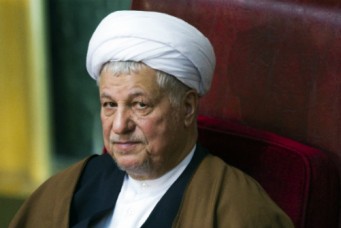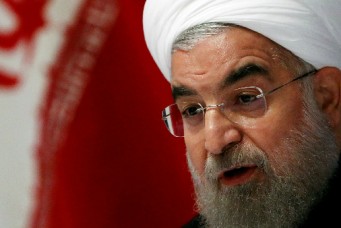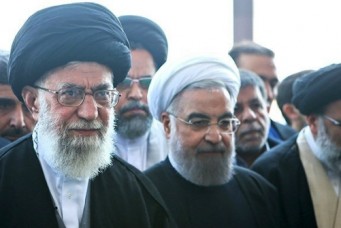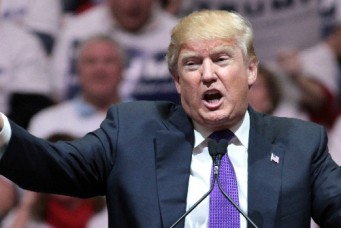The Leader
Iran’s colorful presidents rivet the world’s attention, but the real power in the Islamic Republic rests with a politician-cleric who is hardly known outside the country: Ayatollah Ali Khamenei. His story explains today’s Iran.
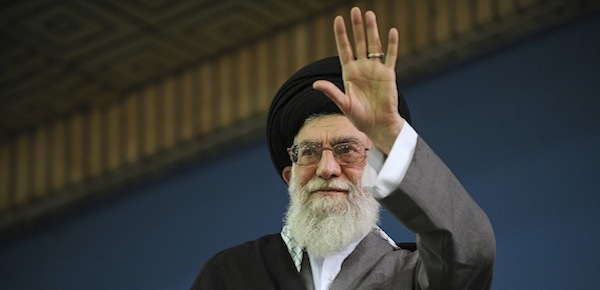
Supreme Leader Ayatollah Ali Khamenei, Tehran, Feb. 16, 2013. Office of the Supreme Leader/Associated Press
In June 1989, Iran’s ruling clerics were in a bind. Ayatollah Ruhollah Khomeini had just died, at the age of eighty-six. Given the fractious politics in post-revolutionary Iran, it was vital that a successor be named as soon as possible to avoid a dangerous power vacuum.
But who could replace the very symbol of the Iranian revolution?
One candidate was already out of the running; Ayatollah Hossein-Ali Montazeri, once the Imam’s designated successor. Khomeini effectively sacked Montazeri just three months earlier, for speaking out against the regime’s brutal excesses and questioning Khomeini’s reading of velayat-y faqih, which made clerics absolute rulers in Iran. But when the Council of Experts met in the Iranian parliament building within hours of Khomeini’s death, its members—all clerics—could not agree on a single individual to become Iran’s next supreme leader.
One of those clerics was Ali Khamenei, then forty-seven and sporting a black bushy beard, who had served as Iran’s president since 1981. Khamenei was a Khomeini protégé during the long struggle against Shah Mohammad Reza Pahlavi. His underground activism landed him in the shah’s prisons six times. Later, after the victory of the revolution in 1979, he dutifully took up all the positions Khomeini instructed him to assume. In the meeting of the Council of Experts, Khamenei, himself just a mid-ranking cleric, spoke in favor of a council to replace Khomeini. But the idea garnered only a small number of votes.
Ali Akbar Hashemi Rafsanjani, a Khomeini confidante who had become the powerful speaker of the Iranian parliament, or Majles, stepped in. He lived next door to Khomeini and had sat at his deathbed; he informed the Council of Experts that Khomeini’s last wish had been for Khamenei to succeed him. According to Rafsanjani’s memoir, Reconstruction and Development, Khamenei objected to this idea. He protested that he had run for president only because Khomeini himself asked him to. He’d lost the use of his right arm in a terrorist explosion in 1981 and complained that official responsibilities tired him. He adored music and poetry, and preferred a task that would allow him more private time.
The prospect of appointing Khamenei was appealing for other reasons. Many members of the Council of Experts hoped to distance the regime from Khomeini’s hardline policies—his persistence in dragging out the war with Iraq for eight years, his anti-Western rhetoric, and his uncompromising attitude toward dissidents—that had isolated the country. Many clerics including Rafsanjani had come to believe that Iran needed more of a ceremonial supreme leader, and that steering the country in a new direction should be left to pragmatic politicians.
Khamenei was certainly known for his non-confrontational style. As president, he had allowed Khomeini to handpick his prime minister, Mir-Hossein Moussavi, who was responsible for the day-to-day affairs of the country. Khomeini once embarrassed Khamenei with a public lashing, accused him of being unaware of the principles of the regime and interfering in matters that did not concern him. Khamenei bowed in silence and never questioned Khomeini’s authority again.
And on that fateful day in June, members of the Council of Experts cast their ballots to choose Khomeini’s successor: Khamenei was elected overwhelmingly, with sixty votes out of a possible seventy-four.
Faith in the Almighty
For a quarter century, nobody has wielded more power in Iran than Khamenei, now seventy-five years old. Compared with Khomeini, or with Iranian politicians such as Mohammad Khatami and Mahmoud Ahmadinejad, Khamenei receives very little attention outside Iran. Even inside the country, though his portrait is plastered in offices and on billboards everywhere, he operates discreetly, usually far from public view. Yet Iranian presidents and parliaments have come and gone while his reign continues—and it has been an autocratic reign.
There is no case to be made that Khamenei rose to the top out of ambition; clearly he was initially chosen because he was considered a relatively weak figure, not a strong one. But the office he assumed was already an extremely powerful one, and it remains so. Before his death, Khomeini ordered a revision of the Iranian constitution in order to cement the authority of the supreme leader of Iran. It mandated Khomeini’s successor to safeguard the Islamic revolution, and gave him alone the final word on matters of state. To ensure regime survival at any cost, Khamenei has repressed dissent at home and isolated Iran in the international community. Fearing the loss of his power, he has even gone to extraordinary lengths to sideline erstwhile allies. The burden Khamenei carried and the power he inherited would transform the poetry-loving mullah into one of the age’s enduring authoritarian rulers.
Khamenei began his rule in 1989 with a typically humble statement: “I am an individual with many faults and shortcomings. I am truly a minor seminarian. However, a responsibility has been placed on my shoulders and I will use all my capabilities and all my faith in the almighty in order to be able to bear this heavy responsibility.” Khamenei declined to move into the modest home/office where Khomeini had lived since returning to Iran to lead the revolution. Khomeini had simply addressed supporters from his balcony, above the small backyard where they gathered. Khamenei moved into an extensive compound in downtown Tehran, close to both parliament and the president’s office. He hired a large staff and set up a modern bureaucracy to monitor the works of government ministries.
In recognition of his position as supreme leader, senior clerics in Qom had little choice but to elevate him from a mid-rank cleric to a senior one, making him an ayatollah. But Khamenei became wary that he might never command the respect of his peers—traditionally, the criteria for becoming a marjah is wide acknowledgement and respect for a cleric’s scholarly work and wisdom, not the assumption of political power. Khamenei began to dismiss senior clerics who had been close to Khomeini, including those in powerful positions in the regime—and replace them with mid-ranking clerics loyal to himself.
Khamenei shared Khomeini’s distrust of the army, which had rebelled against the previous ruler—the shah—and sided with the people. Khomeini had founded the Iranian Revolutionary Guard Corps, an ideological force that was loyal to him and whose mission was to protect the revolution. Khamenei called the army and the Revolutionary Guards the two wings of the regime, but he invested heavily in the latter and expanded its militia, the Basij. He appointed their commanders and shuffled them regularly. Soon he surrounded himself with a network of petty clerics and Revolutionary Guards commanders—none with any notable revolutionary background.
Two ideological positions guided Khamenei from the beginning. Though paying lip service to freedom of thought, he has resisted demands for political and social liberties. He believes that permitting dissent, even limited dissent, amounts to the collapse of the revolution. He argued that the notion of freedom in Islam was different than that of the West. Islam favors protecting individuals not only from one another, but also from themselves and from society, he argued. In November 1991 he said: “Freedom doesn’t mean that one person, perhaps an influential orator, should be free to misguide an entire society.”
Secondly, Khamenei has fiercely opposed improving relations with the United States. Washington severed diplomatic ties in 1979, after Islamist students attacked the American embassy in Tehran, and held diplomats hostage with the backing of the Iranian regime. Khamenei has consistently repudiated rapprochement with the United States, and used animosity toward Washington as a tool to bolster his regime’s popularity. Dismissing talks with America as naïve, he has blocked any effort that could possibly lead to reconciliation. “Negotiation in political terms means a deal,” he said in May 1990. “It means compromise; it means that you need to give something to get something else in return. What do you want to give away from the Islamic revolution? The United States wants your loyalty to the revolution. It wants your pride. Are you willing to give it away?”
Unholy Alliances
Domestic power politics, as much as ideology, have shaped Khamenei’s autocratic rule. Rising public discontent after the destructive war with Iraq, and new domestic political and economic challenges, led Khamenei into a close alliance with Rafsanjani, who had succeeded Khamenei as president of Iran. As Rafsanjani wrote in his memoir, “We made important decisions together.”
Together they faced an emerging campaign led by Islamist intellectuals who had become disillusioned with the course of the revolution even before Khomeini’s death. With Khamenei in power, they became increasingly vocal in criticizing the regime for the lack of political and social liberties. They launched new publications, circulated treatises about democracy and Islam, and condemned the regime’s suppression of dissidents. They allied with Montazeri, under virtual house arrest in Qom, whose liberal tendencies made him a symbolic threat to Khamenei’s rule. In a speech in February 1996, Khamenei lashed back. “They have intentions to harm the system,” he declared. “They are the enemy.” Other opponents criticized Rafsanjani’s government for corruption, mismanagement, and soaring inflation.
At one point, the clash with domestic opponents even entangled Khamenei in questions about the murky death of Khomeini’s son, Ahmad. He died in mysterious circumstances in 1995 at the age of forty-nine, a week after giving a public speech accusing Khamenei and Rafsanjani of misrule. Iranian newspapers reported later in 1997 that the Intelligence Ministry, which fell under Khamenei’s thumb, was behind the killing of some eighty dissidents, including Ahmad. Khomeini’s grandson told Iranian scholar Emadedin Baghi that authorities had revealed to him that his father had been among the victims of those killings.
Khamenei endorsed Rafsanjani’s pragmatism in the post-Khomeini era. Rafsanjani abolished the war economy that had provided rationed food, and reinstated a more liberal economy, importing goods from American-made household appliances to technology. He built dams and roads, and revived a civilian nuclear program that had been interrupted by the upheavals of 1979. In 1995, Russia agreed to complete two nuclear power reactors in the southern city of Bushehr.
Rafsanjani began mending ties with Western countries and drew Iran out of its isolation. But Khamenei’s view of Rafsanjani soured over the latter’s olive branch to Washington. Khamenei believed that any kind of compromise with Washington would put Iran in a weak position and invite more pressure. Washington had repeatedly criticized Iran’s human rights records and attacked its radicalism at home and outside the country. In response, in nearly every public speech, Khamenei called the United States the “enemy” and “world arrogance.” He claimed that Washington intended to overthrow the Islamic regime. “The world imperialism is the enemy of the Islam because it knows that Islam is against its looting,” he said in February 1992. “Our enemies are afraid of the Islamic Republic because they know that our government is the first Islamic regime founded upon Islamic principles. It has massive support, and cut the hands of those who want to control our nation.” A decade later, in 2003, Khamenei’s rhetoric was unchanged. “What the United States, which has been spearheading the aggression against our Islamic revolution, expects from our nation and government is submission and surrender to its hegemony, and this is the real motive for U.S. claims regarding weapons of mass destruction, human rights, and democracy,” he said.
Khamenei faced the first serious challenge to his rule in 1997 with the election of Mohammad Khatami as Rafsanjani’s successor as president. Khamenei backed a conservative cleric who favored the status quo, while religious intellectuals supported Khatami, a former culture minister who campaigned on a platform to reform the Islamic system. Khatami talked about civil society and government accountability, new terms in Iran’s political discourse. With young people, women, and liberals quick to support the new face, Khatami won a landslide victory with a historic 20 million votes.
Khamenei viewed Khatami’s popularity as a major threat. The election unleashed a national debate about the future of the Islamic regime, the freedoms it needed to grant, and how much power the supreme leader should hold. Press freedom began to flourish, facilitating open discussion of these issues. But Khamenei’s judiciary proceeded to confront the emerging movement of Iranian democracy activists; it jailed reporters, and shut down dozens of publications.
The closure of a reformist newspaper in 1999 triggered the largest protests in the country since the revolution. Khamenei’s Basij militia force attacked a dormitory, where the students had held a vigil in support of the publication. It was brutal; they clubbed the students, pushed some of them out windows, and wrecked the rooms. One student was killed and dozens were seriously injured. The raid infuriated the nation and precipitated a week of massive protests. Khamenei appeared on television before a crowd of supporters, denouncing both the attack on the students and the protests as inappropriate. Wiping away tears, he said: “I have a worthless life and a maimed body. I have an honor which you have given me, but I will sacrifice all that to guard the revolution and Islam.” Immediately afterwards, Revolutionary Guards commanders published a letter to Khatami, warning that they would end the protests by force if Khatami did not withdraw his supporters from the streets. Fearing heavy bloodshed, Khatami complied.
Khamenei emerged triumphant and unchallenged. The showdown had exposed the hurdles that Iran’s 1989 constitution had created for democracy. Khamenei, alone, appoints the heads of the judiciary, commanders of the Revolutionary Guards and Basij, members of the Guardian Council who vet election candidates, head of the state television, and the ministers in charge of national security departments such as foreign affairs, intelligence, defense, and the interior. No one could challenge him.
Khamenei’s Man
In Mahmoud Ahmadinejad, Khamenei finally had a president who promised to be a political and ideological ally. Khamenei clearly backed Ahmadinejad’s bid in the 2005 election. The Revolutionary Guards and Basij openly campaigned for him. A runoff vote pitted Ahmadinejad, a little known engineering professor who had served a brief stint as Tehran mayor, against Rafsanjani, a Khomeini confidante, former president, and a founder of the Islamic Republic. Ahmadinejad won, with seventeen million votes against Rafsanjani’s ten million. The message was clear: Khamenei was in charge.
At his inauguration, Ahmadinejad bent forward and raised Khamenei’s hand to his lips, reminding many of Khamenei himself kissing Khomeini’s hand in 1981 when he became president. Ahmadinejad publicly said that his relationship with Khamenei was that of a father and son. Khamenei backed Ahmadinejad when his economic policies caused skyrocketing inflation, when he cracked down on free speech, and when his rhetoric deepened Iran’s international isolation. Ahmadinejad put Iran at the center of controversy with provocative statements, such as calling the Holocaust “a myth,” and reviving a statement by Khomeini that Israel should be wiped off the map.
With high oil prices, and the United States mired in military operations in neighboring Iraq and Afghanistan, Khamenei sought to expand Iran’s regional influence. He repeatedly said Iran could assist America in those countries if Washington treated Tehran as an equal partner. Khamenei would go as far as to claim that Iran was the inspiration for the “Islamic awakening” in Tunisia and Egypt. But during Ahmadinejad’s presidency it was Iran’s pursuit of a nuclear program that best reflected Iran’s determination—under Khamenei’s direction—to flex its strategic muscle.
Khamenei has consistently declared that Iran would not surrender to international pressure, including punitive economic sanctions. “They know that we are not after nuclear weapons,” Khamenei said in August 2006. “They are unhappy about scientific progress in an Islamic state, a country that has not surrendered to the policies of the United States, a country that has shown it is not afraid of America. They don’t want us to have the most important technology in the world, which is nuclear technology. But we have made our decision and are determined to continue the path of struggle that we opted for twenty-seven years ago.”
Taste of Freedom
Many Iranians remained disenchanted with the regime. Iranian society had gone under a metamorphosis since 1979. The majority of people now lived in the cities; they were literate and educated; more than half of university students were women. People had access to the Internet and satellite media—sources of information that shaped their views every day. Iranians had tasted freedom. Terms such as civil society and government accountability had become part of everyday vocabulary. Many believed the nation did not need “a father.”
When Ahmadinejad ran for re-election in 2009, millions of Iranians threw their support behind Mir-Hossein Moussavi—the politician who had served as Khamenei’s prime minister. Pro-reform activists, students, even Rafsanjani’s son and daughter, rallied behind him. Khamenei backed Ahmadinejad again. In the weeks leading to the election, people campaigned in celebratory convoys, believing they could use the election, the small window that the law granted them, to make a slight difference.
Voters flocked to the polls in huge numbers in the capital and in other cities. Historically, a large turnout meant victory for the pro-reform candidate. But ominous omens began to appear after the polls opened. Ahmadinejad’s government shut down Iran’s text messaging services; the tool that Moussavi’s campaign was using to monitor the balloting. Many polling stations lacked a sufficient number of ballot papers. In some areas, Basij forces attacked voters outside polling stations. An early official vote count put Ahmadinejad in the lead. Not long afterwards, Khamenei congratulated Ahmadinejad, signaling that the regime had made its choice.
The next morning, protests spread throughout Iran demanding new elections. With the streets still filled with demonstrators a week later, Khamenei took the podium at Tehran University to lead the nation’s Friday prayer service. With his disabled hand resting on a rifle, he denounced the protesters. “Flexing muscles on the streets after the election isn’t right,” he said. “It means challenging the elections and our democracy.” Without naming other presidential candidates, he called on them to pull their supporters off the streets. “If the political elite ignore the law—whether they respect it or not—they will be responsible for the ensuing bloodshed and chaos,” he warned.
Khamenei thus openly put himself at the forefront of the battle. The next day, Khamenei’s forces fired on the people. Dozens were killed, thousands arrested, and hundreds tortured. Many former officials and leading politicians, including some of the founding members of the revolution and two presidential candidates, Moussavi and Mehdi Karroubi, found themselves in prison. Around the country, protesters chanted “Death to Khamenei,” and “Death to the Dictator.”
Nazila Fathi was the Tehran correspondent for the New York Times from 1999 to 2009. She is the translator of The History and Documentation of Human Rights in Iran by Shirin Ebadi, the 2003 Nobel Peace laureate. She received a 2010 Nieman Fellowship at Harvard University, and was a Joan Shorenstein Center Fellow at Harvard’s John F. Kennedy School of Government in 2012. She is currently a research fellow at the Belfer Center for Science and International Affairs at the Kennedy School. On Twitter: @nazilafathi.

